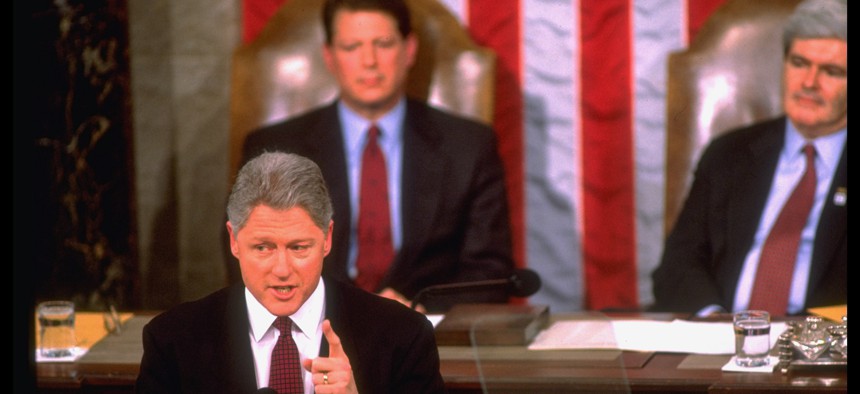That Time Bill Clinton Declared ‘The Era of Big Government Is Over’
Spoiler alert: It wasn’t.
Editor’s Note: This is the first in an intermittent series looking back at groundbreaking, newsmaking, appalling and amusing events in government history.
Last year, the federal government of the United States spent $6.8 trillion. The Treasury Department helpfully explains that it pays for “programs that ensure the well-being of the people of the United States.”
In a pandemic, of course, that’s a lot of programs and a lot of money. Still, even if you factor out COVID-19 spending, the federal government is huge and getting bigger every year—at least in terms of spending. Federal employment has held relatively steady at around 2 million employees for decades.
The ongoing growth of government is interesting, since we are now more than a quarter century away from President Bill Clinton’s famous declaration that the “era of big government is over.” The moment came on Jan. 23, 1996, during that year’s State of the Union address. Here’s the quote in context:
We know big government does not have all the answers. We know there's not a program for every problem. We have worked to give the American people a smaller, less bureaucratic government in Washington. And we have to give the American people one that lives within its means.
The era of big government is over. But we cannot go back to the time when our citizens were left to fend for themselves. Instead, we must go forward as one America, one nation working together to meet the challenges we face together. Self-reliance and teamwork are not opposing virtues; we must have both.
The line garnered polite applause, but hardly a standing ovation. Some Democrats weren’t quite ready to sign on to seriously shrinking government, and more than a few Republicans were skeptical that Clinton was serious about reducing the size of the federal bureaucracy. Even the president himself didn’t seem thrilled to be delivering the line. The fact that the next sentence after his big proclamation started, “But…,” hints that he wasn’t fully committed to the notion.
After all, Clinton had won election in 1992 not by promising to slash government, or to expand it, but to “reinvent” it. He and Vice President Al Gore, who headed the reinvention effort, promised a “common sense government” that “works better and costs less,” not a federal bureaucracy that was markedly smaller in terms of its ambitions.
The problem was Republicans had swept to control of both houses of Congress in the midterm elections of 1994 by promoting a “Contract with America” that was a small government manifesto. It proposed eliminating, privatizing and consolidating whole agencies and Cabinet departments, slashing federal employment, and trimming federal pay and benefits. And it was a huge political success.
Clinton had tried to triangulate his way out of the big vs. small government debate, but there was no third way out of this situation. Backed into a corner, he decided to accept that Americans by and large, believed that government was simply too big.
The reinventing government effort entered a new phase, known as “REGO II,” in which attention was focused more on cutting government down to size than making it function better. The shift didn’t result in sweeping change, but that wasn’t really the idea. By concentrating their efforts on consolidating and shrinking agencies, Clinton and Gore hoped to stave off elimination of entire agencies or Cabinet departments.
By and large, that worked. Republicans ended up not being able to claim much in the way of success in their assault on big government. They promised much in their first hundred days, but delivered little in the way of tangible results. And they never did succeed in eliminating agencies or departments.
Public administration professor Paul Light later did an exhaustive analysis and determined that a true measure of government’s direct and indirect showed it was actually growing in a robust way. “Clinton would have been much more accurate to say that the era of big government was continuing pretty much unabated,” he wrote in 1999. “And that is precisely what the vast majority of Americans want.”
During his 2000 presidential run, Gore tried to put the whole thing in perspective. “We have promoted the useful nature of self-government in solving problems that must be addressed, while simultaneously reducing the size of government,” he said in an interview with National Journal. “So I think the world has moved on, and while the era of big government is over, the era of big rewards for bashing big government is also over.”
Neither of those statements turned out to be true.
Government continued to grow in areas ranging from homeland security to consumer financial protection. Republicans continued to make hay out of characterizing Democrats as free-spending big government-loving liberals.
By the time the 2016 election rolled around, Democrats on the whole had decided to stop playing defense against that charge. “We should not be paralyzed by the Republicans and their constant refrain, ‘big government this, big government that,’ said Hilary Clinton in a Democratic candidates’ debate. Bernie Sanders, pressed on his espousal of massive new federal programs during a town hall, finally said, “Fine, if that is the criticism, I accept it.”
Today, the big-vs.-small debate lacks the intensity it once had, since there’s general agreement that a pandemic requires a robust federal response. But it’ll be back. After all, the argument has been around since the founding of the country. Just ask Thomas Jefferson or Alexander Hamilton.








